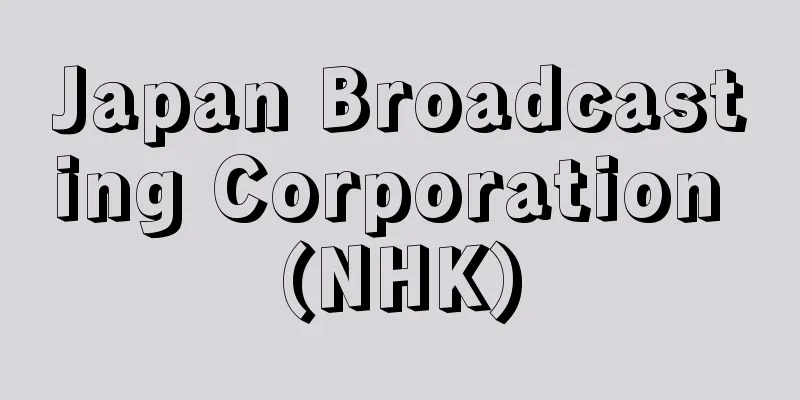Japan Broadcasting Corporation (NHK)

|
NHK is a public broadcasting organization established under the Broadcasting Law as a special corporation. It is operated through viewing fees. In addition to Radio 1, Radio 2, and NHK-FM, NHK also broadcast FM text multiplex broadcasting in some areas from 1996 to 2007. In addition to General TV, Educational TV (E-TV), BS1, and BS Premium, NHK also broadcasts high-definition TV (→HDTV) and text multiplex TV broadcasting. NHK broadcasts internationally via TV and shortwave radio. It was originally founded as the Tokyo Broadcasting Station, which began radio broadcasting in March 1925, the Osaka Broadcasting Station, which began in June of the same year, and the Nagoya Broadcasting Station, which began in July of the same year (all incorporated associations). These stations were merged in August 1926 to become the Japan Broadcasting Corporation (NHK). In June 1950, the Broadcasting Law came into effect, and the NHK was converted from an incorporated association to a special corporation. Its highest decision-making body is the Board of Governors. In February 1953, NHK began Japan's first regular TV broadcasting. In September 1960, regular color television broadcasting began. In November 1963, the first television satellite broadcast between Japan and the United States was carried out, reporting the breaking news of the assassination of President John F. Kennedy. In 1964, the first satellite broadcasting in the history of the Olympic Games was carried out at the Tokyo Olympic Games. In 1985, television text multiplex broadcasting began. In 1987, 24-hour broadcasting began on Satellite TV 1, followed by private broadcasters in the metropolitan area. In 1989, regular broadcasting began on Satellite TV 1 and Satellite TV 2. In 1994, practical test broadcasting of high-definition television began. In 2000, satellite digital television broadcasting began on three channels, Satellite TV 1, Satellite TV 2, and high-definition, and in 2011, these were reorganized into two channels, BS1 and BS Premium. In 2003, terrestrial digital television broadcasting began. The headquarters is located in Shibuya Ward, Tokyo. (→Television, Broadcasting Industry) Source: Encyclopaedia Britannica Concise Encyclopedia About Encyclopaedia Britannica Concise Encyclopedia Information |
|
放送法に基づいて設立された特殊法人の公共放送機関。略称 NHK。視聴者からの受信料収入によって運営される。国内向け音声では,ラジオ第1,ラジオ第2,NHK-FMのほか,1996~2007年 FM文字多重放送を一部の地域で実施していた。国内向けテレビジョン放送としては,総合テレビ,教育テレビ(Eテレ),BS1,BSプレミアムに加え,ハイビジョン放送(→HDTV),テレビジョン文字多重放送を行なう。国外向けにはテレビと短波ラジオによる国際放送を実施する。前身は 1925年3月にラジオ放送を開始した東京放送局,同年 6月に開始した大阪放送局,7月に開始した名古屋放送局(いずれも社団法人)の 3局で,1926年8月に統合されて社団法人日本放送協会となった。1950年6月に施行された放送法により,社団法人から特殊法人に転換。最高意思決定機関は経営委員会である。1953年2月,日本初のテレビ本放送を開始。1960年9月,カラーテレビ本放送開始。1963年11月,日米間の初のテレビ衛星中継を実施,ジョン・F.ケネディ大統領暗殺の速報を伝えた。1964年には東京オリンピック競技大会でオリンピック競技大会史上初となる衛星中継を行なった。1985年テレビジョン文字多重放送を開始。1987年から衛星放送の衛星第1テレビで 24時間放送を開始,その後首都圏の民間放送が追随した。1989年衛星第1テレビ,第2テレビの本放送開始。1994年ハイビジョン実用化試験放送開始。2000年衛星第1テレビ,第2テレビ,ハイビジョンの 3チャンネルで衛星デジタルテレビ放送開始,2011年 BS1と BSプレミアムの 2チャンネルに再編。2003年地上デジタルテレビ放送開始。本部所在地は東京都渋谷区。(→テレビジョン,放送業)
出典 ブリタニカ国際大百科事典 小項目事典ブリタニカ国際大百科事典 小項目事典について 情報 |
>>: Japan Travel Journal - Nihonhoshoshi
Recommend
Assured Destruction Strategy
A nuclear strategy proposed by US Secretary of Def...
Friedrich Wilhelm Bessel
German astronomer. A founding father of practical...
Death of Yoritomo - Yoritomo
A play. One act, two scenes. Written by Mayama Sei...
Guo Pu - Guo Haku
A Chinese literati from the Eastern Jin Dynasty. ...
Togo - Togo (English spelling)
A country in eastern West Africa, facing the Gulf...
Mauremys japonica (English)
… [Takahiro Matsui]. … *Some of the terminology t...
Roughbush - Roughbush
...It is also used for dyeing, dyeing it grayish-...
Gastric emptying test
Food eaten is stored in the stomach, mixed with ga...
Tsankov, Aleksandur
Born: June 29, 1879, Oryahovo Died July 17, 1959, ...
"Records of the Transmission from Okusado" - Records of the Transmission from Okusado
… The oldest cookbooks that exist today are the C...
"Friends of the Family" - Kateinotomo
…Published by Fujin no Tomosha. First published i...
Jogger
...The term jongleurs (from Occitan (southern Fra...
Dutch Broadcasting Corporation - Dutch Broadcasting Corporation
...It was founded as a city in 1424, and was not ...
Duel in the Wilderness
An American film produced in 1946. Original title:...
Guide Michelin
A guidebook for travel, hotels, and restaurants in...









